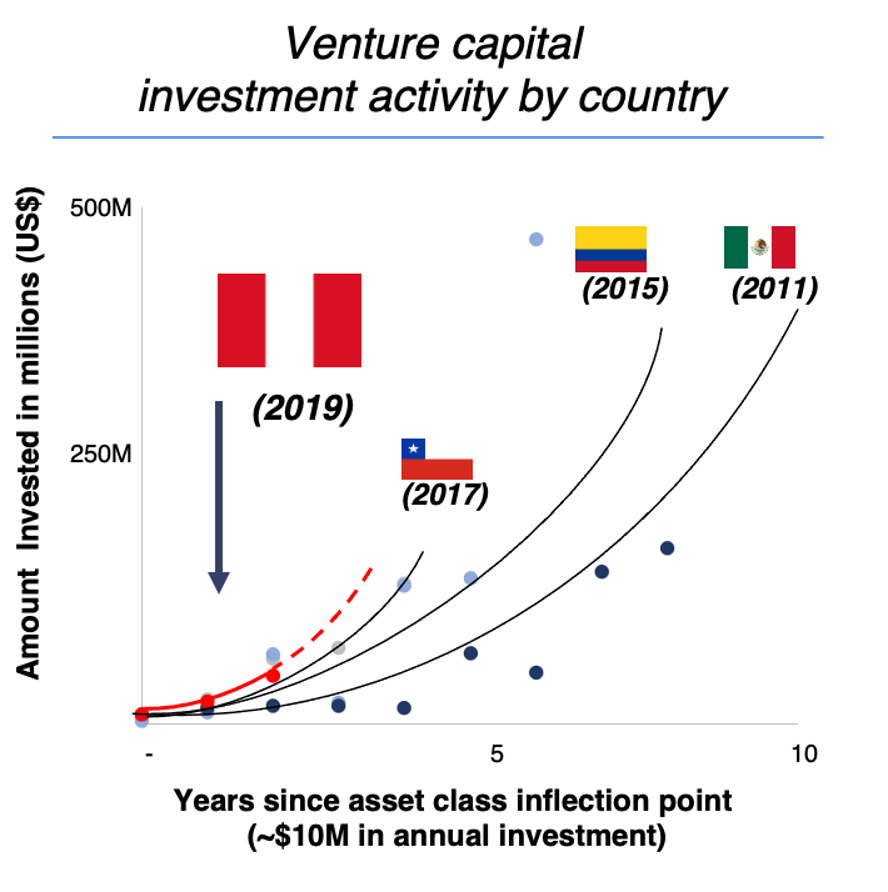Peru’s startup moment has arrived. What are we waiting for?
In early 2020, I wrote that Peru’s startup ecosystem was ready for a leap forward. The country was at the inflection point of building a vibrant venture capital industry. Then the pandemic hit. Two years later, Peru’s local venture capital industry seems to be running in place.
Stuck in the second wave
Over the last fifteen years, startup ecosystems across Latin America have followed similar paths of progress. I remember Nate Lustig, of Magma Partners, first using the term “waves” to describe to me the evolution of the industry across the region.
Picking up on that observation, I have observed three distinct waves of startup ecosystem development in Mexico, Colombia, Chile and Peru. The first wave starts with the support of local governments, which have laid a necessary foundation by offering grants, providing visibility and congregating key actors in order to stimulate an dynamic ecosystem effect. The second wave crests when venture capital funds begin to crop up and success stories are shared of startups that are able to raise capital from international investors . Finally, the third wave is the inflection point of consolidation, when startups led by serial founders have the backing needed to break out and become regional companies worth more than $100M.

As the diagram above shows, Peru got a later start than its neighbors, but has been following a similar path. By 2017, it had entered the second wave. Local success story Crehana has demonstrated the potential of talented entrepreneurs to address a relevant societal issue in Latin America and raise capital from regional investors. Today, Peru is still searching for the third wave.
Take off point
Across Mexico, Colombia and Chile, it has seemed that when venture capital investment reaches $10 million annually an inflection point occurs in the local capital supply. The inflection point also seems to be linked to the timing when local development banks enter the market with funds of funds. When these two triggers occur, funding has grown quickly in each market. This is where Peru stands today.
Additionally, the growth curve of venture funding in each subsequent country to reach the inflection point seems to quicken. It took Colombia less time to get from $10M in funding to $200M than it took for Mexico to do the same. This is promising for Peru, which although getting a later startup could growth more quickly.

Sources: AVP, Startupable, LAVCA.
The amount of funding received by Peru startups in 2019, right before the pandemic, was similar to that of neighboring countries at their respective take off point for venture capital formation. The third wave was ready, a critical mass of startup founders, more and more serial founders. Two years later the deal flow is still there, but local capital supply and investor activity has yet to increase significantly.
Building blocks in place
By the beginning of 2020, Peru was ready for the third wave of startup ecosystem development. The building blocks were all there. First, a critical mass of serial founders with sufficient technical skills. Second, the foundational support from government programs like StartupPeru and well-connected, active accelerators like UTEC Ventures. Third, rising market adoption rates of technology, especially among Lima’s ten million people. Finally, foreign funds with a regional perspective backing Peru startups.
Today, dozens of Peru startups receive seed stage funding rounds each year. Many are expanding across Latin America. Local venture capital funds managed by Winnipeg Capital, Inca Ventures, The Board, and AVP have led seed stage rounds in Peru startups. Notably, all of these funds are privately funded. UTEC Ventures churns out multiple startup batches each year. This activity has opened up new avenues for funding and success for startup founders in Peru. Now, more local founders are entering Y Combinator, catapulting to a global source of financing.
The flow of investment opportunities has increased at the same time that the level of founders has improved. These are a new generation of startups, built more agile and with more experienced teams than the previous generation. They are quickly building teams and scaling regionally.
What are we waiting for?
Despite all the building blocks being in place, investors have yet to capitalize on the opportunity and lead the next stage of consolidation for the venture industry.
COFIDE’s fund of funds was announced in 2019 and launched officially in 2021. The local development bank signaled as late as July of 2021, that they would fund at least three funds by the end of 2021. On January 31st, it announced its first investment in Salkantay Ventures, a Peru-based fund, that previously received a grant from Produce to pay for fund organization and matching management fees. To date, only one of Salkantay’s eight investments is in a Peruvian startup. On the corporate venture side, large local players Belcorp, BCP, and Enfoca have mostly invested outside of Peru.
Meanwhile, international venture capital funds DILA, ALIVE Ventures, and Alaya have each made multiple investments in Peru. Kaszek, in many respects the leading venture capital fund in Latin America, recently announced an investment in Peru startup Crack the Code.
AVP Seed Fund I, the fund I manage, passed up on great opportunities in Peru startups during 2021. These include Kurios and Habi, which later entered Y Combinator, as well as Megabite and TiendDa, both led by proven, serial founders.
Surely, each investor has reasons for passing up on investment opportunities, but taken together, this stalling out of investment activity indicates a failure of local capital to meet Peru’s startup moment. One thing is for sure, Peru’s talented startup founders won’t wait for local investors to catch up. They will find success with or without us.

2 thoughts on “Still on the cusp”